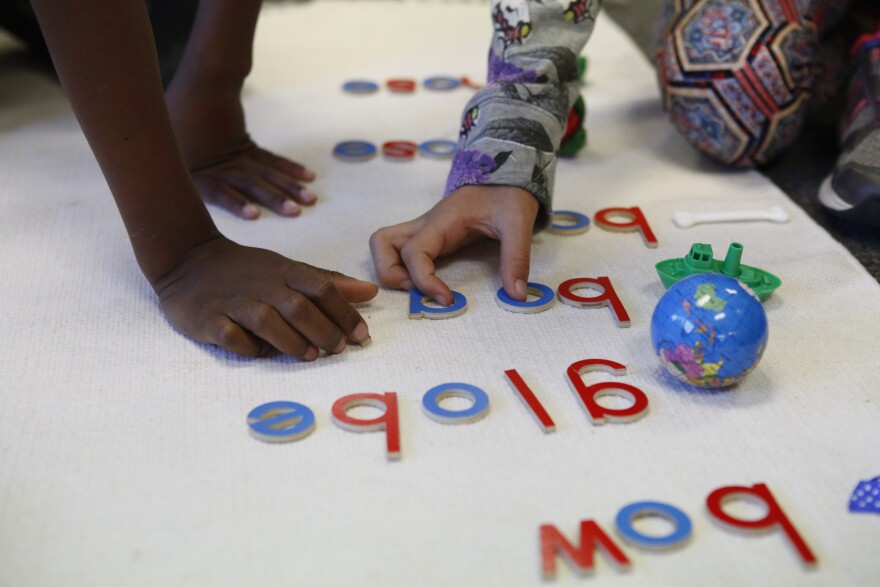On the last day before winter break, Belgrade elementary students are practicing pronunciation in the speech pathologist's office.
“Can you say rain?” Lindsey Schumacher asks as she holds up a flashcard to work on speech exercises. “Good, now, I’m kind of hearing that I think you’re kind of using your throat. You need to just use your tongue.”
Schumacher likes to see kids make progress with their speech. But because of the position’s low pay, she says this job is a stepping stone toward another career in dental hygiene. She works with kids in the morning, and takes classes in the afternoons.
“I do really enjoy this," she said. "I could see myself staying here longer term if the wages were higher. But dental hygiene is nice. Tor me it’s the lifestyle I want to live. I want to raise a family."
Recruiting and retaining paraprofessionals like Schumacher have long been challenges for Montana schools, especially this year, says Lance Melton, executive director for the Montana School Boards Association.
“COVID has definitely amped that up quite a bit for everybody," he said, even schools that in the past could easily recruit staff. "It’s now kind of a statewide issue."
School districts in Gallatin County are trying a variety of approaches to fill paraprofessional staff positions. Belgrade is using federal COVID-19 relief dollars for staff referral bonuses. Other districts are offering referral, and sign on bonuses for some types of paraprofessionals. In rural areas, schools are asking parents to fill in gaps.
None of the strategies, though, have led to schools being fully staffed.
Darren Strauch, superintendent of the K-8 Monforton district west of Bozeman, says schools have decided not to use federal funds for recruitment incentives.
“I think that the concern that we have is that any time you utilize sort of those federal funds for trying to offer incentives, what’s the long term impact of that?" he said. "What happens when those funds are no longer available?"
Instead, Monforton has leaned on parents and grandparents to fill in paraprofessional staffing gaps. Around 25 parents regularly volunteer to help with crosswalk and lunch duty; three volunteer inside the classroom.
Amanda Hendrix-Komoto is a Monforton parent who teaches full time at Montana State University. She says she's happy to help out, but hopes it isn’t the school’s long term plan.
“The one thing I worry about is devaluing paraprofessional labor by making it volunteer," Hendrix-Komoto said. "I don’t want the role of pulling people out to help them with a particular reading skill or to give them a chance for a challenge, I don’t want that to become all volunteer.
"It's nice to have that training. Not all parents do."
In nearby Bozeman Public Schools, the district has had a hard time finding special education paraprofessionals to work with students who have learning disabilities. The district raised wages for special education paraprofessionals twice in the past year, and is offering sign-on and referral bonuses.
Even with those incentives, says interim Superintendent Casey Bertram, it’s hard for hourly workers to justify what it costs to live in Bozeman. Meanwhile, he says the district is receiving plenty of applications for certified teaching positions — and this has driven some changes in the classroom.
“Let’s say the program has one special ed teacher and is serviced by 3 paraprofessionals, and in that program, we’re unable to hire the paraprofessionals; we can’t find anyone," Bertram explained. "If we’re able to find a certified special ed teacher, then that program becomes a two-teacher program and just operates without paraprofessionals.
“What we are realizing is we can’t continue to do what we have always done, and if we are reliant on a large number of paraprofessionals to make it work we might need to revisit how we deliver it,” he said.
Bozeman's recruitment incentives expire at the end of the year, and there aren't yet plans to extend them. Meanwhile, federal funds that can be used for staffing costs are available until 2024.
Lance Melton with the school boards association encourages districts to use these dollars to help fill positions while they search for other solutions.
“We can try to rethink it right now, but the complications associated with COVID-19 are not leaving an awful lot of room for immediate experimentation or innovation," he said. "The fact is in a lot of these cases we’ve got families and students who are stressed and who need immediate increased services."
When the school year picks up again in January, the need for one-on-one instruction will still be there as districts take another look at how to provide student support.



